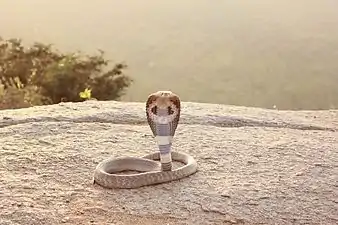Elapoidea
The Elapoidea are a superfamily of snakes in the clade Colubroides, traditionally comprising the families Lamprophiidae and Elapidae. Advanced genomic sequence studies, however, have found lamprophiids to be paraphyletic in respect to elapids.[5][6] In describing the subfamily Cyclocorinae, Weinell et al. (2017) suggested some or all subfamilies of Lamprophiidae should be reevaluated at full family status as a way to prevent the alternative, which is classifying them as elapids.[6]
| Elapoidea | |
|---|---|
 | |
| Indian cobra (Naja naja) | |
| Scientific classification | |
| Kingdom: | Animalia |
| Phylum: | Chordata |
| Class: | Reptilia |
| Order: | Squamata |
| Suborder: | Serpentes |
| Clade: | Colubroides |
| Superfamily: | Elapoidea Boie, 1827 |
| Families, subfamilies and genera | |
Below is the phylogeny of Elapoidea after Weinell et al. (2017), with the interrelations of Elapid after Lee et al. (2016)[4] and Figueroa et al. (2016):[5]
| Elapoidea |
| |||||||||||||||||||||||||||||||||||||||||||||||||||||||||||||||||||||||||||||||||||||||||||||
Notes
- The elapids in the past were considered to have two subfamilies–the Elapinae made of terrestrial species and Hydrophiinae made of the marine species.[1] In 1997, Slowinski, Knight and Rooney found in their phylogenetic analysis using amino acid sequences from venom proteins, that the Australasian terrestrial species nested within the Hydrophiinae. This led to removing the Australasian terrestrial species and placing them in Hydrophiinae.[2][1] This has been supported in subsequent recent genomic analyses, though these same studies also found the subfamily Elapinae to be paraphyletic in respect to the Hydrophiinae.[3][4][5] These studies have found coral snakes, cobras and mambas, kraits, and African gartersnakes forming successive outgroups to Hydrophiinae.[4][5] Since clade names are available for these groups with the exception of the Elapsoidea, bringing back the subfamilies Calliophiinae, Micrurinae, Najinae, and Bungarinae is ideal.
References
- Mattison, C. (2007). The New Encyclopedia of Snakes. Princeton University Press.
- Slowinski, J. B.; Knight, A.; Rooney, A. P. (1997). "Inferring Species Trees from Gene Trees: A Phylogenetic Analysis of the Elapidae (Serpentes) Based on the Amino Acid Sequences of Venom Proteins". Molecular Phylogenetics and Evolution. 8 (3): 349–362. CiteSeerX 10.1.1.324.3013. doi:10.1006/mpev.1997.0434. PMID 9417893.
- Pyron; Burbrink; Wiens (2013). "A phylogeny and revised classification of Squamata, including 4161 species of lizards and snakes". BMC Evolutionary Biology. 13: 93. doi:10.1186/1471-2148-13-93. PMC 3682911. PMID 23627680.
- Lee, M. S.; Sanders, K. L.; King, B.; Palci, A. (2016). "Diversification rates and phenotypic evolution in venomous snakes (Elapidae)". Royal Society Open Science. 3 (1): 1. Bibcode:2016RSOS....350277L. doi:10.1098/rsos.150277. PMC 4736917. PMID 26909162.
- Figueroa, A.; McKelvy, A. D.; Grismer, L. L.; Bell, C. D.; Lailvaux, S. P. (2016). "A species-level phylogeny of extant snakes with description of a new colubrid subfamily and genus". PLOS ONE. 11 (9): e0161070. Bibcode:2016PLoSO..1161070F. doi:10.1371/journal.pone.0161070. PMC 5014348. PMID 27603205.
- Weinell, J. L.; Brown, R. M. (2017). "Discovery of an old, archipelago-wide, endemic radiation of Philippine snakes". Molecular Phylogenetics and Evolution. 119: 144–150. doi:10.1016/j.ympev.2017.11.004. PMID 29162550.
This article is issued from Wikipedia. The text is licensed under Creative Commons - Attribution - Sharealike. Additional terms may apply for the media files.